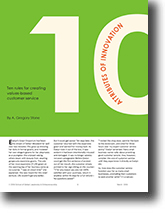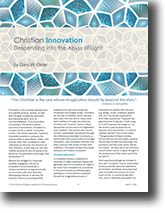| |
|
|
| |
[From the Editor]
|
|
| |
|
|
We are honored to have Dr. Gary Oster as our guest editor for this special issue on The Customer and Innovation. Gary thrives on the subject of innovation. He lives it, breathes it and true to his work as an associate professor in business innovation and leadership, he shares it.
As one of the most giving and humble individuals I know, his love for the subject of innovation is perhaps second only to a desire to know our Creator that we may fully experience the potential of a boundless imagination.
I invite you to explore the ideas shared in this issue and as always, enjoy the read. |
|
|
|
 |
Revaluing the Customer as Community: Rediscovering Markets While Singing in Perfect Harmony
By Bramwell Osula
Traditional markets were once bustling places full of life and humanity. Local owners would cry out to passers-by to examine their wares or taste their delicacies. Shoppers were neighbors and business transactions were direct social exchanges among members of community. Today, reaching customers is a much more daunting effort for some businesses. Many of today’s successful companies, however, have found there is wisdom in tradition as they find new ways to approach customers and consider them members of a community. As Christians, we are exhorted to build relationships through the development of community so that we may value, nurture, and encourage our brothers and sisters, wherever they may be.
|
 |
Ten Attributes of Innovation: Rules for Creating Values-Based Customer Service
By A. Gregory Stone
Customers are the lifeblood of every company. Customer service includes all corporate activities that support the delivery of products or services. Everett Rogers’ diffusion and adoption theory is historically used to explain the rate of adoption for innovations. The attributes of an innovation—relative advantage, compatibility, complexity, trialability, and observability—directly affect its rate of adoption. The rate of acceptance is proportionate to the degree to which each attribute is present in the innovation or product. If customer service is considered the innovation, then these five attributes may be proactively used to strategically plan for and predict customer service outcomes.
|
 |
Small. The New Big
By Seth Gordin
Organizations have long prided themselves on physical growth and expansion as a sign of success. Yet no sooner than the recent collapse of the U.S. financial markets, have organizations recognized that size is less significant than the impact and magnitude of one’s ideas. Smart companies can do more with less. They are drawn to the freedom of greater control of ideas with less layers and hierarchy. In this new era of business, smaller is greater.
|
 |
Christian Innovation: Descending into the Abyss of Light
By Gary W. Oster
Invention and innovation are results of entrepreneurial brainstorming sessions where sparkling ideas are conceived about bringing success to a proposed project or finding solutions for a burning societal problem. A traditional approach to invention is to take a critical problem then analyze it by logical means to find out a set of solutions. But another way of invention, or innovation, is a technique called creative visualization where one’s subconscious mind is involved in a deeper level intellectual process that releases ideas as intuition. As a co-creator appointed by the Creator, the entrepreneur who taps into this type of invention or innovation, transcends the potential limits of human imagination and ultimately benefits society at a greater level.
|
| |
|
| |